The Biggest Enemies of Long-Term Food Storage (It’s Not Looters)

![]()
As preppers are well aware, preparing your home and family for long-term crises and emergencies involves accumulating a substantial food supply.
When it comes to protecting a large food supply, many people focus on the threat of looters and marauders. However, the true enemies of your food supply are likely to be far less dramatic.
Whether you’re putting up the food you bought at the store or produce from your own organic garden, a full pantry represents a significant investment of time and money. Protecting it from these six food storage enemies takes planning, patience, and persistence:
Looters can also threaten food supplies, but in this article, we’re focusing on the six enemies listed above because they are the most common, and we encounter them every day.
 Time has a way of wearing everything down.
Time has a way of wearing everything down.
Everyone knows that various storage methods lead to a wide range of outcomes. For example, dried beans can be stored much longer than canned beans, which can be stored much longer than cooked beans in the refrigerator.
Related: How to Dry Can Beans and Rice for 20+ Years Shelf Life
Not only do you need to understand the best preservation method for the food you’re storing, but you also need to know the life expectancy of the food in your pantry. Sometimes, old food can still be safe to eat, but time has rendered it rancid or imparted an odd flavor or odor, so it won’t be palatable.
Label and date everything in your pantry, including storage and expiration dates. It’s handy to have that information easily accessible when you’re inventorying your food pantry and rotating your stock. That way, you can use or discard expired items and replenish your pantry to help keep this food enemy at bay.
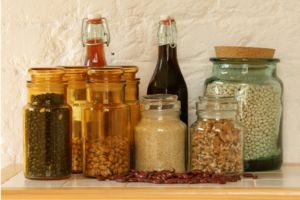 Just like UV rays cause wood to fade and plant material to disintegrate, they also cause your food to go bad.
Just like UV rays cause wood to fade and plant material to disintegrate, they also cause your food to go bad.
Over time, exposure to light causes food to break down, degrading its nutritional value, color, and flavor. Vitamins A, C, E and thiamine are particularly vulnerable to light and deteriorate rapidly when exposed to it.
Light can affect foods that have a high fat content, like nuts and oils. When these foods are exposed to light, the fats oxidize and turn rancid. Not only do rancid foods taste bad, but the oxidation can also produce chemical compounds that are harmful to your health.
Store foods in areas with minimal light exposure, like your root cellar, basement, or pantry without windows. If your pantry does have a window, use a blackout curtain. Consider storing foods like nuts, oils, and grains in dark, opaque containers like amber jars or metal tins.
 The air in your home, pantry, or root cellar might seem empty, but it’s full of bacteria, mold, and yeast spores. Exposure to air is a problem and explains why you can safely eat a rare steak, but you shouldn’t eat a rare hamburger. While the surface of the steak has never been exposed to air, the hamburger has been ground, exposing all those small surface areas to bacteria that are in the air.
The air in your home, pantry, or root cellar might seem empty, but it’s full of bacteria, mold, and yeast spores. Exposure to air is a problem and explains why you can safely eat a rare steak, but you shouldn’t eat a rare hamburger. While the surface of the steak has never been exposed to air, the hamburger has been ground, exposing all those small surface areas to bacteria that are in the air.
In addition, air is made up of about 20% oxygen, which is one of the biggest enemies of food. Oxygen feeds the microorganisms that attack your food, causing food to spoil faster.
As we saw with light, oxidation changes the chemical composition of food and causes it to break down. Oxidation typically involves both light energy and oxygen, but some types of oxidation can occur without oxygen. However, removing air by creating a vacuum removes most of the elements that cause oxidation.
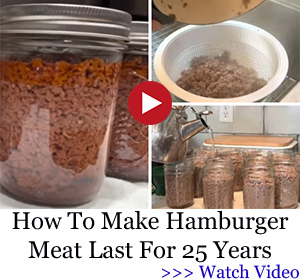 Creating a barrier between your food and the surrounding air is critical to minimizing exposure to protect your food.
Creating a barrier between your food and the surrounding air is critical to minimizing exposure to protect your food.
Airtight containers are a good choice for many types of food, like grains, rice, and beans.
Vacuum sealing is another option that works well with food preservation methods like dehydrating and freezing and will help keep all types of food preserved longer.
Almost no other problem associated with food storage is as discouraging as pests. Whether it’s issues with rodents in your root cellar or bugs in your flour, pests can ruin food supplies in a matter of days.
Rats and mice can chew through food packages and contaminate your pantry with droppings and urine. Insects like weevils, beetles, and cockroaches can get in your flour, pasta, cereals, and grains and make them inedible.
Pest infestations can quickly spread and destroy your entire food supply. Even worse, rodents are well-known to carry pathogens, including bacteria and viruses, which is what happened during the Bubonic Plague. Insects can carry diseases, too, including salmonella and listeria.
Addressing pest infestations requires prompt action and effective pest management strategies. Ignoring the problem will lead to even greater losses.
Integrated pest management solutions are the key to solving issues with rodents and insects in your food supplies.
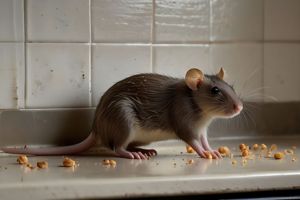
Prevention should be the priority, and you can start by keeping your food supplies in a sealed area without cracks and using pest-proof containers. Clean spills immediately and regularly inspect the area for signs of pests. Other approaches to include in your overall pest management plan include traps, baits, and natural repellents.
Various types of food can be stored for different lengths of time at different temperatures. High and low temperatures can ruin food, but it’s also important to avoid temperature fluctuations, especially with grains, beans, and flour. Temperature fluctuations can lead to condensation in a food container, and moisture will promote the growth of mold, yeast, and bacteria.
If you have frozen foods and experience a power outage, your food may start to thaw. As soon as the conditions are right, the naturally present bacteria in organic matter will start to flourish, and your food will begin to spoil. Although you may choose to refreeze it, you should consider changing the expiration date. Learn here what to do with all your frozen food once the power goes out.
With home canned goods, temperatures over 100° F (38° C) can cause food spoilage, especially if they are left at high temperatures for long periods. The risk of food spoilage goes up with increased temperatures.
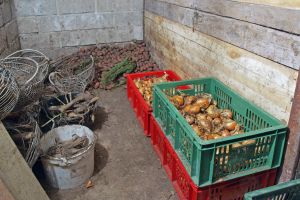 Not everyone lives in a perfectly climate-controlled house, and you may have to deal with some temperature fluctuations. Ideally, your food storage location should be cool with a stable temperature. Many root cellars are deep and well-insulated enough to maintain year-round temperatures of 40° to 45° F (4° to 7° C), making them one of the best places to store food.
Not everyone lives in a perfectly climate-controlled house, and you may have to deal with some temperature fluctuations. Ideally, your food storage location should be cool with a stable temperature. Many root cellars are deep and well-insulated enough to maintain year-round temperatures of 40° to 45° F (4° to 7° C), making them one of the best places to store food.
Whether your food is stored in an underground bunker, root cellar, freezer, refrigerator, or pantry in your kitchen, moisture and humidity levels can impact its longevity.
Some foods, like root vegetables, actually do better with some humidity, which is why they store well on the floor of your root cellar. However, other foods do not tolerate moisture at all, and even a small amount of condensation inside a container of dried goods can ruin it.
Related: Root Cellar Mistakes You Need to Avoid at All Costs
Too much condensation can lead to faster spoilage in frozen and refrigerated foods, like when you see the condensation in plastic containers in your refrigerator. Sometimes, the condensation in frozen food packages causes freezer burn, which impacts the flavor and texture of the food.
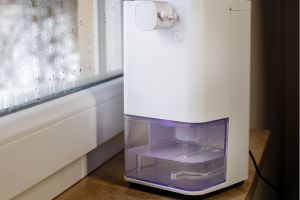 Start by ensuring that your food storage areas have the right humidity level.
Start by ensuring that your food storage areas have the right humidity level.
For example, in a damp root cellar, you may need to consider using a dehumidifier and increasing air circulation by adding vents. While foods like dried goods require packaging in an airtight container, other foods need a little air.
Store fruits and vegetables in your root cellar in burlap bags, pantyhose, wooden crates, or mesh bags to allow air circulation and prevent moisture buildup.
Avoid overpacking containers when packaging food for long-term storage. When freezing vegetables, drain them well after blanching and blot them dry with a towel to remove as much moisture as possible.
When it comes to long-term preparedness, there’s a lot to know. Mastering food storage techniques starts with a basic understanding of these six key enemies, but it doesn’t end there. Continually learning and trying new things to see what works for you, your family, climate, region, and food storage areas will take you on a lifelong journey.
Each type of food and every preservation method presents unique challenges, but if you stay open-minded to learning new techniques as they come along, you can be in a better position to protect your food supply.
Every prepper has a story about food preservation or something that others can learn from! Share your biggest challenges and victories related to this topic in the comments below, and hopefully, we can all learn from each other how to keep food safe, fresh, and ready for any situation.
You may also like:
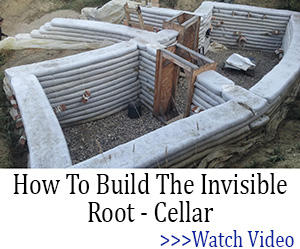 8 Worst American States to Be in When SHTF
8 Worst American States to Be in When SHTF
Why You Should Never Build a Tall Fence Around Your House (Video)
Looming Grain Shortage. Do This Before It’s Too Late
If You’re Planning To Bug In, Stop Doing This Immediately
